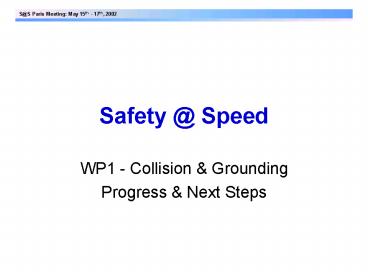Safety Speed - PowerPoint PPT Presentation
1 / 29
Title: Safety Speed
1
Safety _at_ Speed
- WP1 - Collision Grounding
- Progress Next Steps
2
WP1 Structure
- Task 1.1
- Confirmation of main causes ?
- Task 1.2
- Formulation of models
- Fault Trees Parameters list
- Next steps
- Task 1.3
- Hazard Area Risk/Cost model (implementation of
models)
3
Goals of T1.2
- Develop detailed models for the identified
factors (Task 1.1) - Human Errors (Sub-Tasks 1.2.1)
- Mechanical and Automation Failures
Errors(Sub-Tasks 1.2.2) - Manoeuvring Error (Sub-Tasks 1.2.3)
4
Characteristics of T1.2
- Partners
- DMI (leader 1.2.1), DAP (leader 1.2.2), BV, VBD,
SIREHNA (leader 1.2.3), METTLE, NTUA, CET - Links
- Input to implementation phase (T1.3)
- Schedule 1/10/01 (start) - 30/9/02 (finish)
- Manpower Partners involvement
5
(No Transcript)
6
Achievements
- Fault Trees (4.0)
- Implementing
- Decisions taken at technical meeting on 22-23
April at DMI - Meeting follow up
- Allocation of Basic Events among T 121/ 122/ 123
- Power Prediction Algorithm
- Parameters list
- Identification of Operational Design parameters
for each Basic Event
7
Next Steps (1/3)
- Fault Trees (4.1) new Parameters
- Definition of new parameters according to
template proposed by UNEW (sub-Task leaders
related members) - Template available on 20/05/02 (?)
- Concise form of Fault Trees (DAP)
- Allocation of new parameters to Basic Events
(sub-Task leaders related members) - By 30/05/02 (meeting at ABS on 31/5)
8
Next Steps (2/3)
- Basic Events Modelling
- Development of models (qualitative description)
for - assessing Basic Events probabilities (Risk)
- calculating result of parameter changes
- in cost, only at generic level
- in probabilities
- sub-Task leaders related members
- By 30/09/02
9
Next Steps (3/3)
- Deliverables D121, D122 D123
- Template provided by UNEW for all WPs (1 to 4)
- sub-Task leaders related members
- By
- 05/09/02, First draft (Helsinki)
- 16/09/02, Internal (WP1) review
- 23/09/02, Implementation of comments
- 30/09/02, Submission for review (ABS, FIN)
10
Technical Presentation
- Fault Trees
- Power Prediction Algorithm
11
Release 4.0
- Fault trees input
- derived from FMECA results made by WP5 people
- developed by BV in another project on Ro-Ro.
- developed by DAP in ATOMOS II IV on a generic
vessel - developed in the brainstorming session in Genova
- Collision
- In Open Sea, in Bad Good Visibility
- In Restricted Waters
- Contact
- with fixed object
- with floating object
- Grounding
- Powered and Drift
12
Example
13
Human Errors
- Human or operator -
- Error
- Failure
- Fault
- Inadequate performance
- etc.
14
Human Errors
- Watch-keeping failure
- Helmsman error
- Wrong use of...
- Did not manage to...
- Forgot to...
15
Definition
A human error (fault, failure) is any inadequate
performance made by the human operator,
crew-member, OOW, helmsman etc.
16
The simple information-processing model
17
The simple human information-processing model
18
Human activitiesautomated
19
Human activitiescross-level
20
Human activitiescomplete
21
Human activities and Performance Shaping Factors
PSFs
PSFs
PSFs
PSF Performance Shaping Factor
22
PSF
- Permanent
- Temporarily
- Global
- Local
- Internal
- External
23
PSF - examples
- Human fatigue
- Personality and attitudes
- Emotional state
- Incapacitation
- Knowledge
- Experience
- Skills
- Communication
- Workplace environment
- Operational task demands
24
PSF causal dynamics
I
II
III
25
(No Transcript)
26
Parameters
27
Further development
- Determination of PSF patterns
- What does they look like?
- Relevance of PSFs in different situations
- Determination of mode of action
- How does parameters influence PSFs?
- Establish functions or relationships between
parameters and PSFs
28
Power Prediction Algorithm
- INPUT
- Speed, length, draught, displacement and water
depth - Variations of the input parameters are
represented by changes in the power curves as to
be expected by physical / hydrodynamic reasons
29
(No Transcript)

